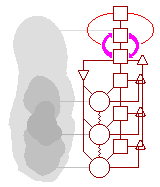Introduction Preface Section 0: Cybernetic Eyes Section 1: The Quick Guide to the VSM Section 2: Case Studies Hebden Water Milling 1985 Triangle Wholefoods 1986 One Mondragon Co-operative 1991 Section 3: Preliminary Diagnosis Janus interlude Section 4: Designing Autonomy Section 5: The Internal Balance Section 6: Information Systems Section 7: Balance with the Environment Section 8: Policy Systems Section 9: The Whole System Section 10: Application to Federations Bibliography Links Appendix 1: Levels of Recursion Appendix 2: Variety  This work is licensed under a Creative Commons Attribution-NonCommercial-ShareAlike 4.0 International License. |
Section 8: DESIGNING POLICY SYSTEMS
System 5: The Design of Policy Systems
Perhaps the biggest problem at Suma in 1986 was that everyone wanted to be involved in every decision and the resulting proliferation of meetings was getting unworkable. While policy clearly requires an input from every member, it had become necessary to get some decisions made only by the members directly involved. The VSM contribution to this problem was:
The situation is, of course, not completely clear. The exact nature of "policy" is indefinable, and it is debatable whether some matters should be decided by an officer or discussed by everyone. The crucial factors are that:
Step 14: Design of Policy Structures
Example 1Suma has been discussed at length. If it may be criticised on its policy systems it must be from the point of view of not letting the officers make decisions on their own. Any slight modification of policy - which could be seen as interpretation of existing policy - has to be discussed by the entire membership. There is little doubt that the weekly Hub/Sector system keeps everyone involved in all policy matters. Example 2Other large co-operatives handle decision making in different ways. They may use a weekly meeting of delegates to take the overview of the current situation, and make decisions on their own initiatives (at Suma, delegates report only their Sectors' views). They then have monthly staff meetings to look at the weekly decisions and to make policy. All weekly decisions and agendas may be pinned on a notice board and members may intervene if they feel it is necessary. Generally this system seems to work, although there are some grumbles about lack of consultation. |
||||||||||||

